“The Curse of Tut” / “The Pharaoh’s in a Rut”
Written by Robert C. Dennis & Earl Barret
Directed by Charles R. Rondeau
Season 1, Episodes 27 and 28
Production code 8729
Original air dates: April 13 and 14, 1966
The Bat-signal: We open with the narrator failing his saving roll against “clever renaming of New York places” by referring to Gotham Central Park. First we have an establishing shot that is stock footage of Central Park in New York City, which cuts to a park that is so obviously a park in Los Angeles (or at least not a park in Manhattan, as you can’t see any buildings). Two guys in mummy masks place an Egyptian statue into the park, and then remove their masks for no compellingly good reason.
The crowd in the park react bizarrely to the statue (one woman screams, and others stand in shock). Then the statue starts to broadcast a voice (which would be the time for screams and shock): “It is written in the stars that on this day shall the great King of the Nile rise up from the tomb and he shall claim his kingdom of Gotham City, and all who oppose him shall be smitten dead.”
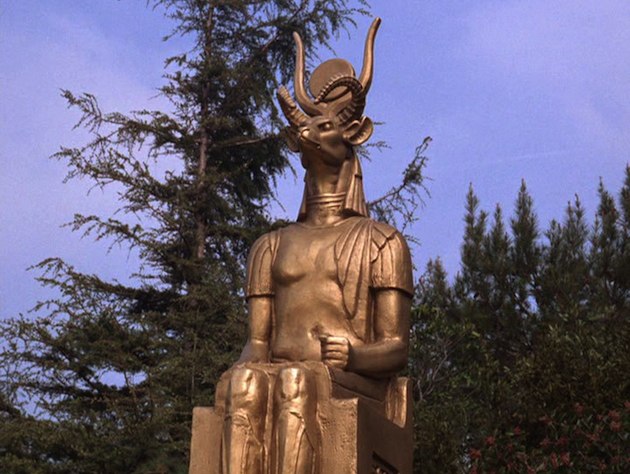
Gordon receives a report about the statue (referred to as a sphinx, but which is in fact a ram-headed god, probably Khnum), but O’Hara points out that it could just be a publicity stunt by the Gotham City Museum, which is opening a new exhibit of Egyptian art. Grumpy about the depths to which press agents will sink in these horrible times, Gordon calls his good friend (and member of the board of trustees of the museum) Bruce Wayne, who is about to go to the museum with Dick and Aunt Harriet. Bruce and Dick are very confused by the receipt of a phone call from Gordon to the house that isn’t for Batman, but he gets over it and answers the phone. Bruce assures the commissioner that it is not a publicity stunt, so Gordon goes to the Bat-phone.
Showing some quick thinking, Alfred grabs a red book off the library shelf, and brings it to Bruce, who “remembers” that he promised the museum trustees that he’d look over that volume for them. He promises Harriet that they’ll go another time—the artifacts have waited thousands of years, after all—and answers the Bat-phone.
They slide down the poles and head to GCPD HQ. They finally come out and say who the villain is: King Tut, who was believed to be killed in a warehouse fire. We also get his origin: he was a mild-mannered Egyptology professor at Yale University until he was struck on the head during a student riot (at Yale????), and now believes himself to be King Tut and that Gotham City is the reincarnation of Thebes, which he must rule. (Why he didn’t believe New Haven to be Thebes is left as an exercise for the viewer. So is why an Egyptology professor would refer to himself as “King Tut” rather than “Pharaoh Tutankhamun.”)
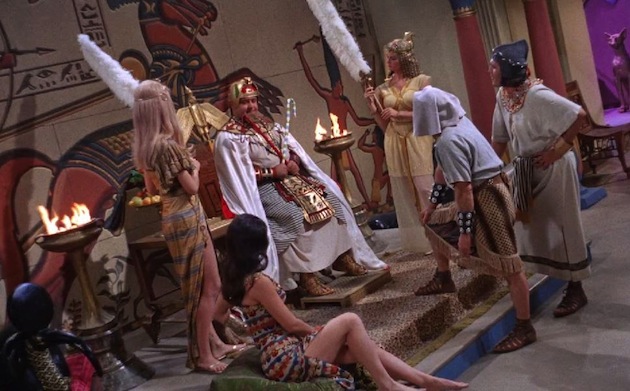
Batman and Robin believe he should be pitied, that he’s a sick man—but with caution, as he is still dangerous. They go to investigate the statue itself.
King Tut himself has set up shop in an old exhibit, with a harem of women and his henchmen, all dressed in Egyptian finery. He explains to his two primary henchmen, the Royal Scrivener and the Grand Vizier, why he announced his plan ahead of time: it’s to lure Batman and Robin to the park for a trap. He also pronounces the Scrivener to be a twit.
Speaking of twits, Batman and Robin arrive at the park, where Batman confidently states that the statue is a “rather good imitation” of the Sphinx at Giza. The statue, in fact, looks absolutely nothing like the Sphinx at Giza (that’s the one with the missing nose that is what everyone thinks of when you say the word “sphinx”).
The statue makes a second announcement: “Whosoever transgresses upon the sacred Sphinx shall be smitten down by Anubis, the jackal god guardian of the cemeteries—and that goes double for Batman.” (They actually got Anubis right, too!) The Dynamic Duo say, “Challenge accepted!” and climb all over the statue. They find a handle, and then Batman, fearing a booby trap, ties a string to it and pulls on it from a distance. A knife juts out from the statue, which would have stabbed anyone who pulled the handle up close.
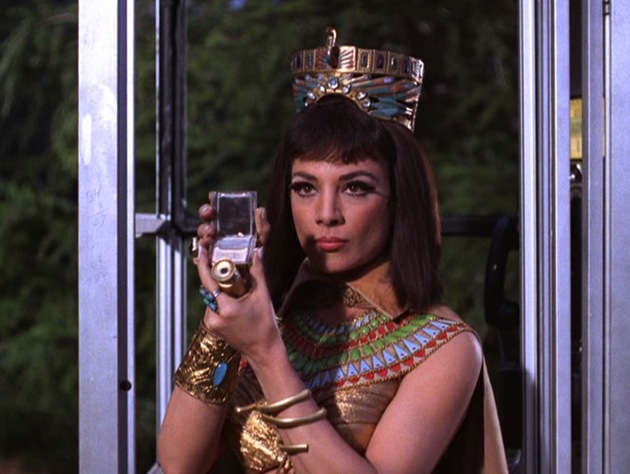
From a nearby phone booth, King Tut’s moll Nefertiti observes. She’s pissed that the trap didn’t work, so she signals King Tut’s nearby truck with her mirror reflected off the sun. King Tut asks what message is brought by Ra (nice touch, as he’s the sun god, so that’s two in a row…), and is furious to learn that the trap didn’t work.
Batman and Robin see her walking across the park, Batman identifying her outfit as fourteenth dynasty, which is also King Tut’s dynasty—which is also wrong, as Tutankhamun was eighteenth dynasty. They try to grab her, but she throws an exploding asp at them and runs away. (Of course, the asp is more associated with Cleopatra than Nefertiti, but we’ll let that one go…) Then King Tut’s henchmen attack, and fisticuffs ensue.
They drive the henchmen off, but don’t go after them, because Batman believes that was the point of the attack. Instead, they’ll nab Tut at the museum.
Later, Bruce is giving a tour to the press of the Egyptian exhibit. He refers to a gold snake as being made of carnelian (which is red, not gold), and refers to the cobra as the symbol of upper Egypt, with the vulture the symbol of lower Egypt—which is precisely backwards, as it’s the other way around. The press nod and assume he’s right because he’s rich and stuff. (Either that or they’re taking notes for their articles on how stupid the idle rich are.) One reporter asks a question, which is notable because he’s African American, quite possibly the first black person we’ve seen in Gotham City…
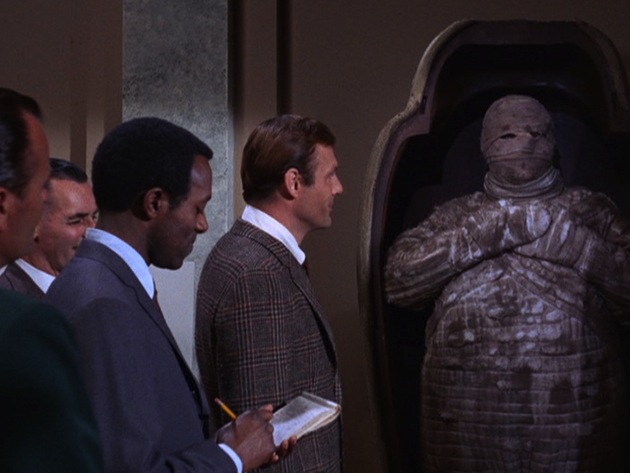
He then takes them to a mummy’s sarcophagus, which he says was of a ruler of the fourteenth dynasty, which would put it in the 1500s BC—except it isn’t, the fourteenth dynasty ended in 1650 BC. He then casually opens the 3500-year-old sarcophagus like it’s a bathroom door and exposes the fragile mummy to open air. Good job of preservation, there, Gotham City Museum!
But then the mummy’s eyes open, and he falls out of the sarcophagus. The reporter immediately says that the prophecy the statue mentioned has come true, which is a helluva leap. They unwrap the head to reveal King Tut, but nobody recognizes him, even though he’s a known criminal. An ambulance is called, and two EMTs show up (who happen to be the Scrivener and the Vizier). Bruce goes with them, and then the Vizier gasses him. They unzip King Tut out of his mummy suit (and why did no one notice the zipper when he fell face-first out of the sarcophagus?) and strap the unconscious Bruce into the gurney. The henchmen go off with Bruce while King Tut sneaks out the service entrance (tossing his mummy suit into a random cabinet in the museum) into his truck. Once inside, he connects to the statue in the park via telephone and puts Nefertiti on the line. She reads off cue cards: “It was written in the stars and it has come to pass. The great king of the Nile has risen from the sands of time to reclaim his lost kingdom.”
She then puts King Tut on, and he declares his first royal act: kidnapping Bruce. He will announce the ransom at a later time, but he warns the cops and the Dynamic Duo to not interfere until then.
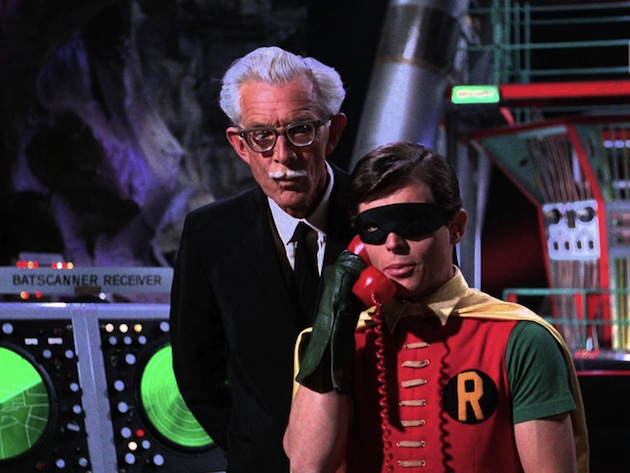
Gordon immediately goes to the Bat-phone, which Robin answers. Robin is devastated to learn that Bruce has been kidnapped, and then stupidly tells Gordon that he has no idea where Batman is. Harriet also heard about the kidnapping on the three-o’clock news, and she’s beside herself.
In the back of the ambulance, Bruce wakes up and tries to get himself out of the ambulance, finding himself exiting via the rear door, the gurney zipping down a hill, and heading straight for a construction site that includes a three-hundred-foot drop. Oops.
However, he manages to break out of the straps just before the gurney goes over the cliff.
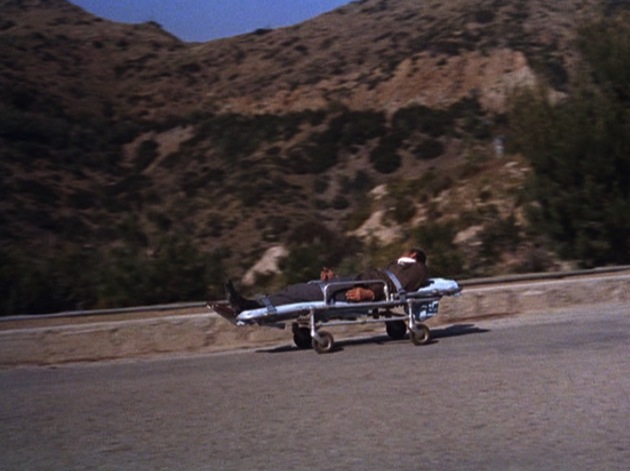
Back at his HQ, Tut turns off the demolition derby (which his harem was watching) to put on the news, which has an interview with Gordon and Batman, where the latter reveals that he “rescued” Bruce himself. Ahem. He also says that he’ll be researching these ancient crimes in the library at Alexandria, and he’ll be on the first jet to Egypt.
Nefertiti makes the mistake of mentioning King Tut’s past as a professor at Yale and he has her taken away by his royal torturers. He intends to take advantage of Batman bouncing around belfries in Egypt to again abduct Bruce.
Of course, Batman’s trip to Egypt is a ruse to lull King Tut into a false sense of security. He knows that King Tut will try to kidnap Bruce again. First he sends Harriet off on a weekend in the country to keep her safe, then he sets up a totally convincing dummy of Bruce on the couch (one which fools Harriet into thinking it’s Bruce asleep). Batman and Robin hide behind a very thin credenza that provides no cover whatsoever, and Batman continues to show his total lack of knowledge of anything Egyptian by announcing that ancient Egyptian super-criminals always struck at six o’clock, or the hour of the hyena (the Egyptians didn’t have labelled hours like that). Robin then asks if there’s anything Batman doesn’t know, and Batman modestly says there are many things he doesn’t know, and boy is he not kidding.
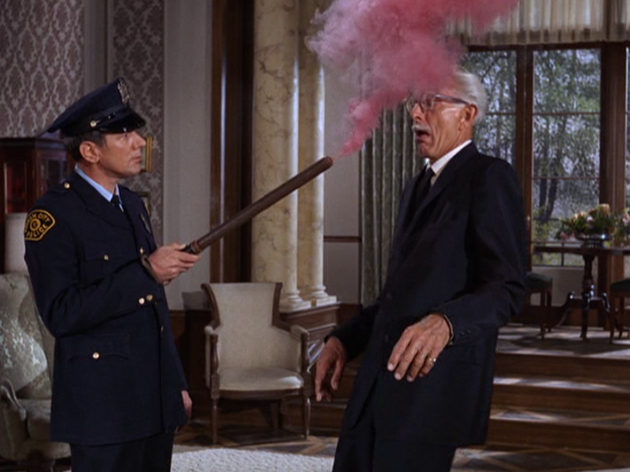
Alfred swallows a universal antidote pill, and then answers the door for a henchman dressed as a cop and using a comedy Irish accent (yes, even worse than Stafford Repp’s). The fake cop gases Alfred, who fakes a fall for appearance’s sake, then the henchman gases the Bruce dummy. The fake cop runs out to get the other henchmen, during which time Robin takes away the dummy and Alfred wraps Batman up in a blanket after Batman leaps dramatically onto the sofa for no compellingly good reason. The bad guys take Batman away. Robin tracks him via the receiver in his cowl, and also calls Gordon and O’Hara (interrupting their afternoon tea) to fill them in.
Unfortunately, the henchmen slug him on the head to be sure, and discover that it’s actually Batman. The clunk on the head also probably damaged the cowl receiver, as Robin loses the signal.
King Tut places Batman in a giant jar, with only his head exposed, right next to Nefertiti. Both of them are subject to the pebble torture, which involves a thousand tiny pebbles being dropped on the victim’s head in succession. Nefertiti has pretty much gone completely binky bonkers, cluck cluck, gibber gibber, my old man’s a mushroom, etc. Batman tries to get King Tut to remember his past as a professor at Yale, but King Tut is having none of it.
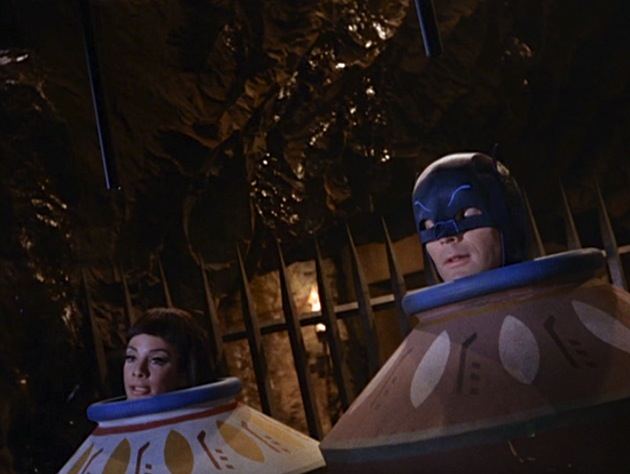
Robin and Alfred try to extrapolate Batman’s location based on what they know of his location, and they realize he’s at the fake Egyptian palace from last year’s Gotham City Expo. Gordon calls to inform them that King Tut has captured Batman and is ransoming him for one million dollars, to be paid by Bruce. But Gordon can’t find Bruce—there’s no answer at his stately mansion—but Robin says he’ll find the millionaire. He and Alfred then go into the Batmobile (Alfred has to drive, as Robin doesn’t yet have a license).
We cut to King Tut’s HQ, where both Batman and Nefertiti are reciting “Twinkle twinkle little bat.” King Tut demands music and instructs his prisoners to dance. We get a dual rendition of the Batusi, but Batman is using it as a cover. He uses his groovy dance moves to punch two henchmen, and then fisticuffs ensue—just as Robin shows up. Batman announces that he recited the multiplication tables backwards in order to keep his sanity.
The Dynamic Duo are victorious, but they go outside to find Alfred dazed and the Batmobile stolen by King Tut. So they give chase in King Tut’s own truck. Batman tries to control the Batmobile remotely, and activate the ejector seat, but it doesn’t work. King Tut then tries to hit them with the Bat-beam, but when he activates the beam, the ejector seat goes off, sending King Tut flying through the air. Batman puts the finishing touches on with a sock to the jaw.
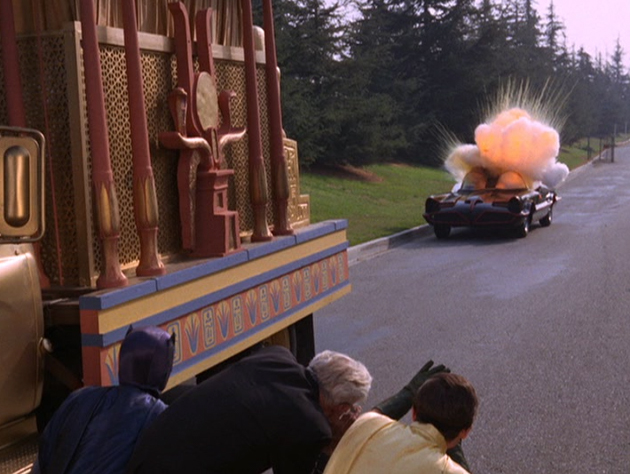
Later, in Gordon’s office, King Tut wakes up restored to his former professorial self. “Whatever will the dean say?” he wonders.
Fetch the Bat-shark-repellant! Robin uses the Bat-scanner to track Batman after King Tut’s people have taken him, but after they lose the signal, there’s only one hope to track him down: THE GIANT LIGHTED LUCITE MAP OF GOTHAM CITY! Hooray! That leads them to the Gotham City Plans and Views machine to find King Tut’s HQ. The Batmobile has Bat-smoke that spews from the back of the car, obscuring it from view of any pursuers, as well as a Bat-beam, but Batman can also (theoretically) control the Batmobile remotely via the Voice-Control Batmobile Relay-Cicruit. In addition, Batman happens to have a perfectly lifelike and convincing dummy of Bruce Wayne just lying around the Batcave…
Robin also has a tiny utility belt transmitter, but I understand there are pills you can take for that.
Holy #@!%$, Batman! Robin’s response to the Egyptian threat is “Holy hieroglyphics!” because of course it is. (It’s got alliteration and everything!) When the statue in the park makes a noise like a howling wind, he cries, “Holy hurricane!” Upon seeing the knife booby trap in the statue, he cries, “Holy whiskers!” When he sees Nefertiti walking across the park, he yells, “Holy masquerade!” He yells, “Holy asp!” when Nefertiti tosses an exploding snake at them. Because he’s stupid, he asks Batman if he’s really going to Egypt, prefacing his query with “Holy travel agent!” After King Tut hits them with the Bat-smoke, he cries, of course, “Holy smoke!”
Also in the voiceover at the end of “The Curse of Tut,” William Dozier says, “Holy cliffhanger!”
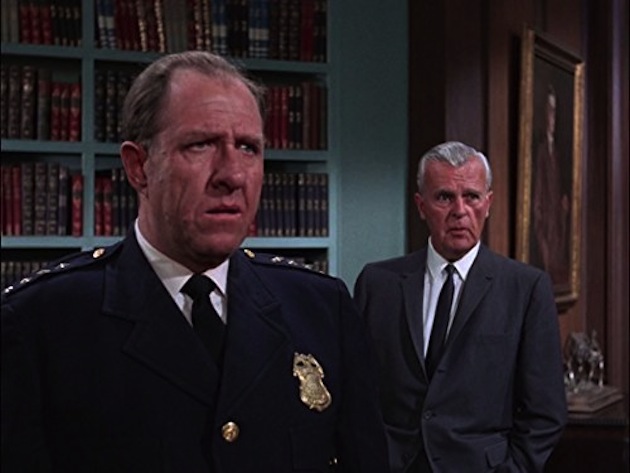
Gotham City’s finest. Gordon calls Wayne Manor. Alfred answers the phone and summons Bruce. Not thirty seconds later, Gordon uses the Bat-phone, and the same guy answers the phone and summons Batman. Then again, he doesn’t notice that Bruce and Batman have the same voice, either.
Gordon also assumes Batman is talking about Alexandria, Virginia, the suburb of Washington D.C., not Alexandria, Egypt. Doofus.
Special Guest Villain. Victor Buono makes the first of several appearances as King Tut, who has the distinction of being the first villain to be wholly created for the TV series. (Technically, Zelda the Great was, also, but she was still based on a character from the comics.) He’ll be back in the second season’s “The Spell of Tut” / “Tut’s Case is Shut.”
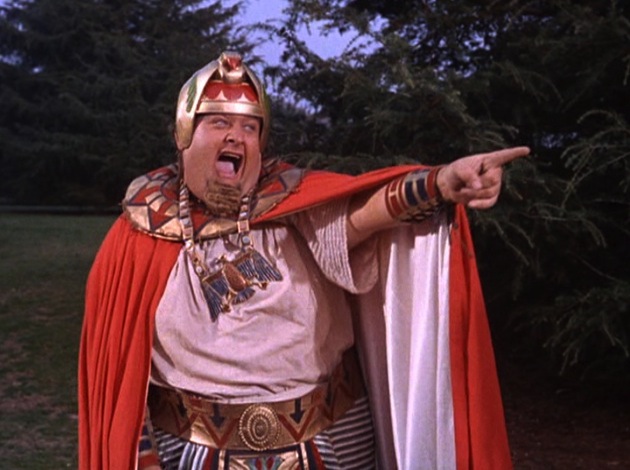
No sex, please, we’re superheroes. Nefertiti says that Batman turns her on: he’s “clean cut and groovy.”
Na-na na-na na-na na-na na.
“Nefertiti, you abandoned wench, how many times must I tell you? Queens consume nectar and ambrosia, not hot dogs!”
“So I get hungry—living on nothing but figs and dates and pomegranates. You want a bite?”
“Aaaaah! Unclean!”
–King Tut’s extreme reaction to Nefertiti eating a hot dog.
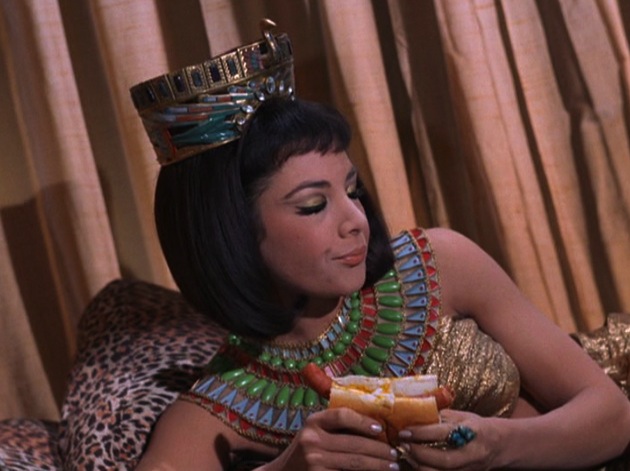
Trivial matters: This episode was discussed on The Batcave Podcast episode 14 by host John S. Drew with special guest chum Jim Beard, author, comics historian, journalist, and editor of the collection Gotham City 14 Miles, which had numerous essays about this series.
Eventually, a version of King Tut did appear in the comics, in Batman Confidential #26 in 2009, by Christina Weir, Nunzio DeFillippis, & José Luis García-López. Instead of William McElroy (which will be established as King Tut’s real name later in the series), the comic book King Tut was named Victor Goodman, a play on Victor Buono (“buono” is Italian for “good”).
King Tut also, like many characters from this series, appeared in the animated series The Brave and the Bold, but because 20th Century Fox actually still owns the rights to televised versions of the character, he had to be renamed the Pharaoh.
Writers Robert C. Dennis & Earl Barret will return to write King Tut’s second appearance next season, though these four episodes are their only Batman credits.
The Grand Vizier is played by Don Barry, who was the lead in The Adventures of Red Ryder movie serial. He’ll be back as Tarantula in “Black Widow Strikes Again” / “Caught in the Spider’s Den” in season 2. Veteran character actor Bill Quinn plays the board member, notable mainly because Quinn’s final screen role was as McCoy’s father in Star Trek V: The Final Frontier. (It’s the least of the connections between the original Trek and Batman ’66—cf. Julie Newmar, Roger C. Carmel, Malachi Throne, Stephen Kandel, etc.—but it amused me.)
The newscaster in “The Pharaoh’s in a Rut” is played by Olan Soule, who would go on to become the definitive animated voice of Batman between 1968 and 1983, doing Bats’ voice on The
Batman/Superman Hour, Scooby-Doo, Sesame Street, and almost all the iterations of SuperFriends. He was replaced for 1984’s SuperFriends: The Legendary Super Powers Show by none other than Adam West, though as a consolation prize, Soule took over the voice of Martin Stein, one half of Firestorm.

Pow! Biff! Zowie! “Loyal subjects and Helots, this is your king.” What a hilarious disaster of an episode. Victor Buono is a delight as King Tut, so far over the top that his nose should be bleeding. In a particularly entertaining touch, his two primary henchmen speak in the same overblown style as him when speaking directly at him, but continue to do so in their Brooklyn-esque thug accents. Meanwhile, Palestinian actor Ziva Rodann, who has a lovely, elegant voice complete with exotic accent, has mostly slang-laden dialogue as Nefertiti (“Home, toots, and step on it!”).
I can’t decide if Batman’s constant stream of misinformation about Egypt is meant to be satirical or if the writers were just too lazy to get it right. Goodness knows, most non-European cultures got a perfunctory treatment at best from contemporary screenwriters (cf. Mission: Impossible, The Man from U.N.C.L.E., etc., not to mention Star Trek‘s botching of Sikhs in “Space Seed“), so it’s probably the latter, but what I love is that it goes beyond the usual oversimplifications. You could just have everyone refer to the statue in the park that totally isn’t a sphinx as a sphinx, but they double down and have Batman say it’s a perfect replica of something it doesn’t look anything like. You could just have Bruce giving the tour to the reporters and discuss the value of the crown, but they double down and have him specify which animal symbolizes which region and getting it entirely wrong.
This is only the second time the cliffhanger has been Bruce in danger rather than Batman, and I’m amused that both here and in “Fine Feathered Finks,” Bruce is bound, lying down, and heading feet-first toward his doom. In this case, though, it’s Bruce’s own stupid fault. Seriously, why did he think busting out of an ambulance and careening down a hill was a good idea?
Some of the social commentary is also hilariously absurd. Student demonstrations were a big deal in the time period, of course: Civil Rights-related and Vietnam War-related. In particular, the University of California-Berkeley was the site of some particularly nasty demonstrations. But the notion of such a riot at Yale, of all places…
At the end of “The Pharaoh’s in a Rut,” Batman implores Gordon to put King Tut (who is being kept on Gordon’s couch? Are the holding cells full?) in a psychiatric institution, but Gordon laments that such institutions are overcrowded and “the taxpayers are blind to our pleas.” Taxpayers? I would think that’s more an issue for those who collect the taxes, yes? And, of course, everyone’s so very concerned for King Tut, but what about Nefertiti, who was driven insane by the pebble torture? Shouldn’t her mental health be of more concern than that of the guy who caused it?
Finally, I love the fact that the Batusi is brought back for no good reason except to bring it back. I mean, really, Batman did not need to go through that charade, he could’ve made with the fisticuffs the minute they broke him out of the jar, but then we wouldn’t get to see more of him busting a Bat-move!
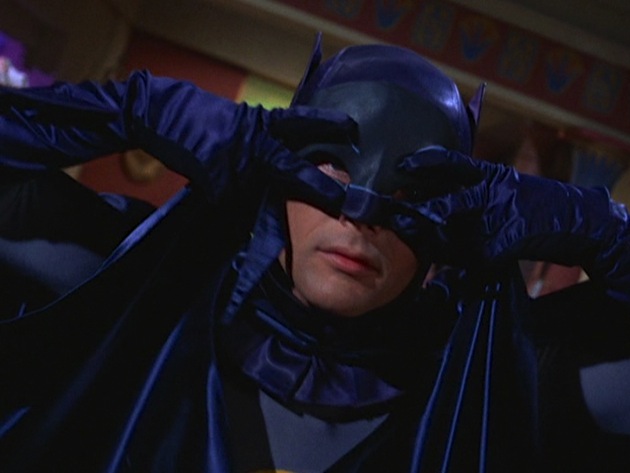
This episode definitely falls into the “so bad it’s good” category, as I was grinning ear to ear the whole time I was watching it. Mostly that’s on Buono, though Adam West has his more-earnest-than-thou meter turned up to 9 on this one, as well.
Bat-rating: 7
Keith R.A. DeCandido is the author of the new Marvel’s Tales of Asgard trilogy. Book 1, Thor: Dueling with Giants, is available now as an eBook, and you can preorder the print edition, which is due in March. You can also preorder the print edition of Book 2, Sif: Even Dragons Have Their Endings, and Keith is hard at work on Book 3, The Warriors Three: Godhood’s End.










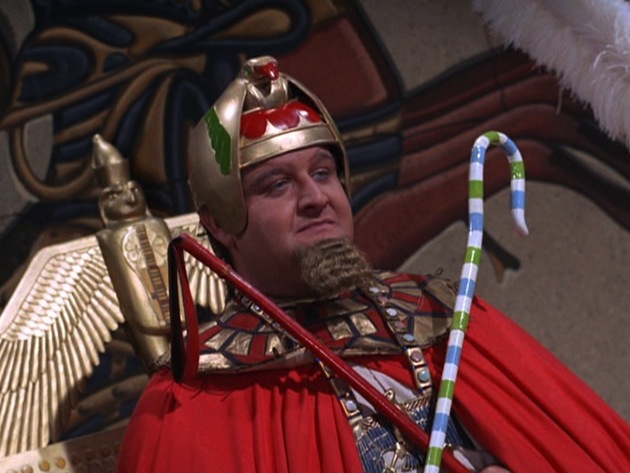
The Egyptology may be a hot mess, but the episode itself is so much fun I don’t care (and that sort of thing usually makes me stabby). One point you didn’t mention was Tut’s use of helots in his speech. Those were the slaves of the Spartans, who were of course Greek. The misdating of the the Fourteenth Dynasty might not be one of their errors; there have been a lot of refinements to Egyptian chronology in the last 50 years. (Who am I kidding? The writers pulled those numbers out of their assess,)
Victor Buono was pretty ubiquitous on 60s TV. That rich voice and over-the-top accent made him perfect for roles like this or snobby connoisseurs or overeducated jerks of any stripe. He’s clearly having fun with this role.
I would have thought 66 was a year or two too early for student riots, but thinking about it I realize it isn’t. They were still confined to a few hotbeds like Berkeley at that point, but they were starting to spread.
Garry Trudeau, the creator of Doonesbury, is a Yalie, and the strip was originally set there. One of the characters in the early days is a studen protester, at Yale.
I think the “Sphinx” thing is one of a number of instances in this show where the production wasn’t able to match the intentions of the script. Dennis & Barret can be rightly criticized for getting the dynasty and dates wrong, but it’s clear from the dialogue that the Sphinx was meant to be larger, given what Robin suggested about it having goons inside. No doubt they intended it to be like the so-called “Sphinx” at Giza (which is not an actual sphinx, just called that by the Greeks by analogy with their own mythological figure), but the art department couldn’t scare up or whip up anything suitable with the available time and budget.
Still, I think this is a reasonably good debut for Victor Buono’s King Tut. He’s a suitably flamboyant and eccentric villain, and Victor Buono brings excellent comic timing and delivery to the role (including a fair amount of W.C. Fields influence at times). Just the casting makes it funny, this jowly fat white guy imagining himself the reincarnation of an Egyptian boy king. (Unfortunately, Adam West overacts a little too much in a couple of scenes.)
I like the way they’re already playing with the opening formula, subverting audience expectations by having Gordon call Bruce first instead of Batman (and then not recognizing the same voices when he calls Batman moments later). I love the cliffhanger too, with Bruce rolling downhill on a stretcher. It’s a nice change of pace from the usual deathtraps. A lot of novelties in this one.
One thing I’ve always found weird is how the royal soothsayer’s divinations accurately warned him that their hostage wasn’t who they thought. I mean, they thought they had Bruce Wayne, but they actually had Batman! Umm… Wait a minute. So… the guy, who wasn’t even a real soothsayer but just a hood working for a delusional professor-turned-gangster, was actually tapping into some sort of supernatural force that told him about the hostage switch… but that force somehow wasn’t aware that Batman actually is Bruce Wayne? That is confusing on so many levels.
Umm… Wait a minute. So… the guy, who wasn’t even a real soothsayer but just a hood working for a delusional professor-turned-gangster, was actually tapping into some sort of supernatural force that told him about the hostage switch… but that force somehow wasn’t aware that Batman actually is Bruce Wayne? That is confusing on so many levels.
And I love it that somebody in the show’s universe actually cut a record of the Batusi.
How do you count the multiplication tables backwards? Do you start at infinity?
Everyone seems to be stealing the Batmobile lately. What happened to the anti-theft system? For that matter, I find it hard to believe that a chubby guy like Tut could overpower Alfred, considering some of Alfred’s future exploits in the show.
Cameo alert — the TV newscaster here was Olan Soule, who would later play Batman on Filmation’s 1968 cartoon and then for Hanna-Barbera in the ’70s.
If all the Egyptian errors were made by Bruce/Batman, and King Tut was accurate, I would lead toward deliberate by the writers.
While you can write off Gordon not recognizing Bruce as Batman (using the Supergirl approach that people don’t expect to see the extraordinary when they look for ordinary), it is amusing that Gordon does not realize they have the same butler.
I am surprised that you think a riot wouldn’t have happened at Yale. Both Harvard and Columbia had major student protests. Why not Yale?
Yale had its share of significant student protests (at one point, there was serious consideration of merging the then all-male Yale with then all-female Vassar and moving the Yale campus to Poughkeepsie as a both a response to the protests (New Haven being much more “urban” than Poughkeepsie) and a way to go co-ed), but to my knowledge they were in the ’68-’70 timeframe rather than 1966.
Yale’s one of the few “real world” locations to be mentioned on the show, in lieu of things like “Londinium” and using “Mayor Linseed” as Gotham’s mayor. Oddly, it was used twice in very different circumstances, as one of Bruce’s ancestors was said to have both attended and founded the Skull & Bones Secret Society there.
Was never a fan of Victor Buono as King Tut as it was too over the top. It was the first sign of things starting to crumble. Mind you, in the course of doing the podcast, I bowed to the majority and have to admit that I do like the fact that the King Tut stories, when you watch them all together, actually have some of the best continuity of any villain in the series.
My big question was why Tut’s flunkies work for him. Most of the villains are more-or-less sane with goals involving robbery and/or revenge. We can assume their gang are in it for the profits, personal loyalty, and whatever personal interest they may have in putting Batman or someone else in a death trap. But, Tut’s crew is supporting a guy they know is nuts and whose goals may not always line up with even Gotham’s flexible standards of reality.
My best theory is that, despite not wanting anyone to mention his Ph.D., these were all students of Tut’s and supporting his taking over Gotham was worth a good chunk of their grade.
Christopher: Thanks for the heads-up on Olan Soule. I totally missed that that was him as the newscaster…….
—Keith R.A. DeCandido
Ellynne: Remember, his main plan was to ransom Bruce Wayne for a million dollars, though that was shifted to Batman. Either way, though, that was a big payday in 1966, and the flunkies were presumably getting a cut….
—Keith R.A. DeCandido
@4/StrongDreams: I don’t think Tut was all that accurate. He’s a middle-aged fat man who believes himself the reincarnation of a teenage boy pharaoh and who talks like a cross between a Brooklyn gangster and W.C. Fields. This is a sitcom, not a history dissertation. It’s a fantasy world where everything is labeled with signs, celebrities and sitcom characters pop out of windows to chat with wall-climbing superheroes, characters are able to use monickers like “Penguin” and “Catwoman” as their actual legal names, and villains go to the trouble to build elaborate themed deathtraps but can’t be bothered to stick around and watch them work. Plausibility was never a concern, so they didn’t bother with research.
As for not recognizing Alfred’s voice on the phone, I imagine most English butlers would speak in very similar tones, so one might just expect them to sound alike. In season 3’s “The Wail of the Siren,” a hypnotized Gordon does recognize Alfred when he encounters him in person in the Batcave.
@5/mabfan: If anything, I think the idea of a student riot at Yale may have been meant as a deliberately incongruous joke. If riots were associated at the time with other, rowdier schools (in public perception), the premise of one happening at a more reputable and staid institution would’ve been funny.
@8/Ellynne: It often seems as if the Tutlings genuinely worship Tut and buy into his claims of godhood. So this could be the comedy equivalent of a religious cult — impressionable people needing to belong, falling for the lure of a manipulative, insane criminal who claims to have divine power.
Then again, maybe they’re just playing along because they need to work. Henching isn’t a profession with a lot of job security in Gotham, since Batman and Robin keep putting all the major employers out of business. Sure, many of them tend to come back periodically and hire anew, but the gig rarely lasts long, and a goon has to take what work is available. And if that means dressing up like an Egyptian and pandering to a delusional college professor, hey, it’s a living.
Why he didn’t believe New Haven to be Thebes is left as an exercise for the viewer.
Seriously: the Grove Street Cemetery is tailor-made for a resurrected pharaoh (or the next best delusional thing) to hang out at. “The Dead Shall Be Raised.”
“Ancient Egyptian super-criminals”… Okay.
krad; Robin apparently had the exact opposite of a tiny utility belt transmitter, and that’s why he took pills, according to legend.
Also, King Tut showed up in the Batman ’66 comic, and he actually had mystical Egyptian objects, travelled back in time, and one of his henchmen, named Waylon Jones, was affected by a cursed item or somesuch and became Killer Croc.
@14/lordmagnusen: Yes, now that the rights have been cleared up, DC has been able to use all the show’s villains in its Batman ’66 comic (although it can’t always use the celebrity likenesses — Chandell is blond, Colonel Gumm’s face is permanently glued over, and Black Widow is a much younger woman who looks and acts nothing like Miss Tallulah Bankhead). Keith is talking about Tut’s use in the main DC continuity. While the comics have adopted a lot of characters from adaptations over the decades — such as Jimmy Olsen and Perry White from radio and Harley Quinn, Renee Montoya, Mercy Graves, and Livewire from the DC Animated Universe — the villains created for this show were unavailable because 20th Century Fox owned them.
I’m not commenting on the rights thing or anything like that, I was just adding this bit about King Tut in the Batman ’66 comic because I believe Keith has mentioned things from it in previous rewatches. It wasn’t a correction, but an addition.
Full name William Omaha McIlroy, as he reveals in “I’ll Be a Mummy’s Uncle”.
@17/Rick Bradford: It’s spelled “McElroy” in the Batman ’66 comics and on Wikipedia, though The Official Batman Batbook rendered it as “Mackelroy.”
I can’t decide if Batman’s constant stream of misinformation about Egypt is meant to be satirical or if the writers were just too lazy to get it right.
Maybe it was a time constraint? How long would the writer have had to put together the script? Today it would be easy to get all the details right with a google search, but what would the writer of this episode have done with what was available at the time? Seems like it would be at least a half-day expedition at the library to double check all the bad information you pointed out. If there wasn’t a half-day to spare, it’s somewhat understandable that the writer just went with their best recollection on, e.g., the vulture/cobra thing and hoped for the best.
@19/dunsel: As I said in post #11, I don’t think the writers of this fantasy sitcom had any interest in factual accuracy to begin with. It’s not like they were actually making a show about Egyptian history. They were making a comedy set in an extremely stylized and absurdist alternate world. Most of the cities and countries mentioned in the show were completely imaginary, or were parodies of real places. In a universe with locations like Gotham City, New Guernsey, Nimpah, Bessarovia, and Londinium, why should we expect their version of Ancient Egypt to be anything like the real one?
The thing that got me in this episode is that Batman somehow knew that whoever would come to Wayne Manor to kidnap Bruce a second time would enter once, knock out everyone with gas, then go back outside and come in again with someone else to grab the body, giving Batman time to replace the Bruce dummy with himself. Several questions on that… 1. How did he know that the person coming would only gas Bruce and then cover his face with a blanket? 2. Bruce was never wrapped in that blanket. How could Batman wrap himself up in that small blanket without anything, including his pointy ears or boots, sticking out? 3. Okay, so Batman knew what the exact method was going to be. But why not just put a Bat homing transmitter on the Bruce dummy and follow them to Tut’s hideout?